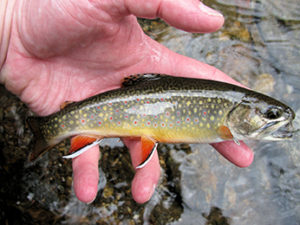DEC Discovers Brook Trout in Previously “Fishless” Adirondack Lake Impacted by Acid Rain
Lake Colden and Tributaries Show Signs of Fish and Habitat Recovery
Decades of New York’s Clean Air Initiatives Helped Reduce Effects of Acid Rain
The New York State Department of Environmental Conservation (DEC) and the Adirondack Lakes Survey Corporation (ALSC) today announced the confirmation of brook trout in an Adirondack lake deemed “fishless” for decades due to the negative effects of acid rain. The discovery of the self-sustaining brook trout population in Lake Colden, a high elevation lake in the High Peaks Wilderness, is attributed to improved water quality directly resulting from the state’s rigorous standards to prevent the airborne pollutants that cause acid rain.
“The discovery of brook trout in Lake Colden illustrates how we can make positive environmental change when we act to prevent the harmful effects of pollution,” DEC Commissioner Basil Seggos said. “New York’s efforts to improve air quality statewide have resulted in cleaner air, and now we have even more evidence that all species can benefit from decisions based on sound science and investments in effective policies. However, this progress is threatened by the constant assault from the Trump Administration on clean air and environmental programs, which is why we will continue to fight to ensure they do not unravel progress like this remarkable restoration. I applaud the commitment of DEC staff across multiple administrations and divisions, our partners at NYSERDA and the Adirondack Lakes Survey Corporation, and other stakeholders who helped make this breakthrough a reality and I look forward to continuing our work to protect New York’s air quality and spur further progress.”
Alicia Barton, President and CEO of NYSERDA said, “The return of the brook trout to Lake Colden is a testament of New York’s long-standing tradition of stewarding the environment. As the federal government ramps up its roll-back of emission regulations, Governor Cuomo’s Green New Deal will ensure our progress in protecting the State’s most precious natural resources and habitats, like the Adirondack Park, from harmful emissions and toxins is sustainable for years to come.”
“This amazing discovery is a direct result of the close partnership and good communication we have with DEC,” ALSC Program Manager Jed Dukett said. “ALSC has been monitoring the chemistry of Lake Colden for years and observing the improvements in the water chemistry. While we were preparing to recommend to DEC the lake was suitable for stocking brook trout, the discovery of brook trout makes this recommendation moot.”
The Lake Colden brook trout discovery is the first time a sustaining fish population has been recorded in a high-elevation (2,764 feet) Adirondack lake previously determined to be unable to host fish due to acid rain impacts. High-elevation lakes and their brook trout populations were severely impacted by acid rain.
How Air Quality Impacted Lake Colden’s Brook Trout
Acid rain comes in many forms – rain, snow, sleet, hail, and fog (wet deposition), and as deposits of acid particles, aerosols, and gases (dry deposition). Acid rain is formed when sulfur dioxide (SO2) and nitrogen oxides (NOx) combine with moisture in the atmosphere to produce sulfuric acid and nitric acid. Several sources that contribute to creating acid rain include the combustion of fossil fuels (coal, oil, natural gas, wood, etc.); emissions from motor vehicles, airplanes, power plants, and industries; and emissions of SO2 and NOx carried atmospherically from the Midwest.
By the 1960s, scientists determined that acid deposition was devastating natural resources across New York. The Catskill and Adirondack Parks were particularly hard hit. Soils were becoming too acidic to maintain healthy forests with noticeable tree die-offs at higher elevations. Many lakes, mountain streams, and some rivers were unable to support healthy fish populations. Lake Colden was considered fishless after a 1987 ALSC survey caught no fish. Subsequent surveys in 2004 and 2011 also failed to catch any fish.
Policy and Advocacy Reduce Pollution
New York State began taking steps to control SO2 and NOx pollution in the 1980s, including Governor Mario M. Cuomo’s 1984 Acid Deposition Control Act. The state also successfully advocated for amendments to the Clean Air Act in 1990 to require federal controls of SO2 and NOx. DEC undertook additional actions in the 1990s and 2000s to reduce in-state sources of pollution through the Acid Deposition Reduction Program. As a result of these and other steps taken at DEC’s urging and by the ALSC, New York State Energy Research and Development Authority’s (NYSERDA) atmospheric deposition initiatives, U.S. Environmental Protection Agency’s Clean Air Markets Division, United States Geological Survey, Syracuse University, among many others, acid rain precursors are emitted at a significantly lower level than before 1985.
Resurgence of Brook Trout
Water samples from Lake Colden and 51 other designated Adirondack Long-Term Monitoring (ALTM) lakes are collected and analyzed several times per year. Since summer 1992, ALSC staff have conducted the field, laboratory, and public posting of data in collaboration with ALTM partners. The ALTM partnership and monitoring efforts continues and more information can be found at DEC’s website. Lake samples are tested for pH and other related water chemistry parameters. In recent years, samples have shown that the water quality was improving.
Using DEC-derived information in August, ALSC staff sought and observed small brook trout in a tributary to Lake Colden while collecting water samples. DEC’s Division of Fish and Wildlife followed up by hiking in nets and electroshocking equipment in September to sample fish populations in the lake and its tributaries. During sampling, DEC discovered the lake contained a viable and healthy population of three generations of brook trout and found brook trout in a tributary. DEC’s discovery demonstrates the lake’s water quality has improved enough to support brook trout and reproduction.
Lake Colden Going Forward
DEC will continue to monitor the lake’s water quality with the assistance of ALSC. DEC is undertaking genetic testing to determine the origin of the brook trout population, which could be a native heritage. DEC Fisheries program staff will also monitor the self-sustaining brook trout population.
In addition, Governor Andrew M. Cuomo recently announced that in next year’s State of the State address, he will introduce an aggressive nation-leading habitat restoration initiative, “Revive Mother Nature.” Revive Mother Nature will support critical environmental restoration efforts, like the restoration of Lake Colden after federal and New York State agencies undertook actions to address acid rain, to help increase fish and wildlife habitat while also making communities more resilient in the face of climate change and severe weather.
One of the highest ALTM sites, the Lake Colden watershed extends to 5,114 feet near Algonquin Peak. This 38-acre lake is located between Mount Colden, the McIntyre Range, and Mount Marshall amid some of the most scenic parts of the Adirondacks. Anglers willing to make the arduous hike to Lake Colden to fish for this newly discovered brook trout population must be aware the use of baitfish is prohibited in the lake.
Learn more about New York’s official State fish, the brook trout, on DEC’s website.
ALSC helps monitor changes to natural ecosystems of the Adirondack Mountain ecological zone with a focus on water quality, atmospheric deposition, fish surveys, and other biological and chemical studies. More information about their work can be found on ALSC’s website.


